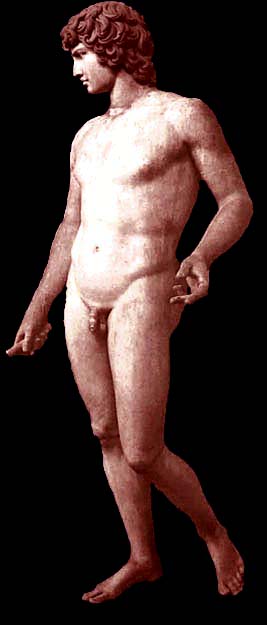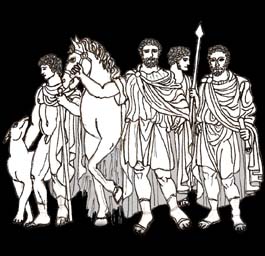

The
Life of Antinous
Antinous was born in a small
town called Bithynium-Claudiopolis, in the northwest corner of Asia Minor,
which we now call Turkey, in the year 111 A.D. He was likely from a family
of minor nobility or influence in the town. Antinous came from nowhere,
but by the end of his short life, he was known all over the world. His
name and image has survived through history because of the mysterious
love that occurred between this strange, exotic young man, and his lover
Hadrian, the ruler of the Roman Empire. The details of Antinous's life
are mostly unknown. The exact year of his birth is unknown but the date
is recorded as November 27th. He was repeatedly described as being an
“Ephebe” at the time of his death which is a Greek term for
a young man of about 18 years of age.
What he looked like is certain, based on hundreds of surviving sculptures,
he was extraordinarily beautiful, a living god, a visible manifestation
of divine perfection. He has been compared to Ganymede, Adonis, and many
beautiful boys whose beauty attracted the attention of the Gods.
The Emperor Hadrian passed through Bithynia in the year 123 A.D. and may
have encountered Antinous for the first time. With his parents permission,
Antinous was sent to be educated at the finest school for boys in Rome,
where he learned the liberal arts, and how to be a model Roman citizen.
He also began training his body in the gymnasium, and over time, under
the guidance of Greek trainers, sculpted it into one of the finest examples
of Classical male beauty.
Antinous was an excellent hunter, which was Hadrian's favorite past time...they
are known to have spent much of their free time hunting wild animals,
including a man-eating lion in the Libyan desert. Antinous surely felt
deep affection for Hadrian's hunting hounds, the finest dogs in the world
at that time and in many ways Antinous can be compared to one of them,
because of his loyalty and devotion, his beauty and youth, his athletic
strength, and the expression in his eyes, all of which conveys deep canine
familiarity.
In his short life, Antinous affected the course of human history, he became
the first historical person to be declared a god because of his homosexuality,
for whom a religion was initiated, which lasted for several hundred years.
His religion prompted Christians to react against homosexuality in ways
that continue to affect us even now.
The relationship between Hadrian and Antinous did not begin until Antinous
reached legal adulthood. There is no contemporary historical evidence
to prove otherwise, despite what many claim. Early Christians spread vicious,
homophobic rumors to exterminate his gay religion, and much of this falsehood
persist to this day. Antinous was the last god of the ancient Roman religion.
The beauty of Antinous is timeless. He is as perfect to our modern eyes
as he was 1900 years ago. He has captivated lovers of male beauty ever
since. Antinous was the first and the longest lasting Male supermodel.
The Imperial Tour of the East
Hadrian is the only emperor
to have traveled throughout the whole of Roman Empire, having visited
every province from Brittania to Israel, and from the Danube to North
Africa, several times. He enjoyed personally overseeing the administration
of his government, and he was deeply interested in improving the lives
of his subjects by tangible means. Hadrian was in love with the Greek
ideal of civilization, and was devoted to carrying his vision of a perfect
world to every corner of the Empire.
So it was that in the late summer of the year 128, the Imperial Court
embarked on a grand tour of the East. The Empress Sabina, Hadrian's wife,
and her attendants were members of the entourage, but on this particular
voyage, Antinous was the most favored of Hadrian's companions. There relationship
was openly, and gracefully displayed before the eyes of the world. This
journey through the East, what we call the Sacred Peregrination, is the
only part of the short life of Antinous that history has conveyed to us.
For this reason it takes on the importance of a sacred epic. Antinous
was in the very flower of his beauty and vigor, he was a shinning star
held in the wings of the Imperial Eagle, and it is no coincidence that
this court of demigods should travel through the lands of Ganymede, Attis,
Adonis, Jesus and Osiris, who were all beautiful souls taken from life
before their time.
The court stayed in Athens for five or even six months, they arrived in
time for the celebration of the Mysteries of Eleusis, which symbolically
portrayed the rape of Proserpina by Hades, the mourning of her mother
Demeter, and the return of Spring. Hadrian maintained a deep interest
in religion, theology and spiritual mysteries. It is believed that Antinous
underwent the secret initiations provided by the priests of Eleusis. Through
them he received the consecration of the dark goddess of the underworld
Proserpina, which prepared him for his own death and resurrection.
After Greece the entourage passed through Asia Minor and visited Bithynia
the homeland of Antinous. They proceeded south to Antioch, and then East
as far as Armenia, making their way south through Arabia, where they crossed
the Jordan and entered Jerusalem. Here Hadrian met with the Rabbis and
engaged them in theological debate. He enacted sweeping reforms upon the
Jewish faith, not understanding the consequences that would later haunt
him when the Jews, led by Bar Kochba, rebelled.
In the summer of 130, the Imperial Court left Israel for Egypt, where
Hadrian was not only Emperor, but Pharaoh...a living God. The great city
of Alexandria with its learned scholars did not however receive Hadrian
as a divine being. Filled with religious controversy, they were opposed
to many of his reforms. The large Christian faction was especially disturbed
by the presence of Antinous and his obvious relationship to the Emperor.
After several difficult weeks, the close companions of Hadrian, a group
of young men, poets and philosophers, escaped to Libya where a great man-eating
lion had been disturbing the countryside. They hunted the beast and Hadrian
and Antinous moved forward, positioning themselves for the kill. Antinous
charged ahead and attacked, but lost his weapon in the fight. The wounded
lion attacked Antinous and would have killed him had Hadrian not intervened
at the crucial moment and brought down the ferocious animal. A poet named
Pancrates wrote of the event and said that red lotus flowers miraculously
sprang from the blood of the lion. These flowers were presented to Antinous,
and soon became his emblem.
When they returned to Alexandria, the entourage swelled to many hundreds,
including the High Priests of the many cults of Egyptian gods. As the
waters annual inundation subsided, Hadrian with religious solemnity gave
the command to board the fleet of elegant, gilded barges and thus Antinous
on his sacred ship began the slow journey up the Nile, a holy journey
against the current from which he would not return.
The Death of Antinous
The Imperial Fleet arrived
in the ancient city of Hermopolis just in time for the celebration of
the death and resurrection of Osiris. These ceremonies coincided with
the end of the flooding of the Nile that was so important to the fertility
of the river valley. For two years the Nile had failed to flood properly,
and the threat of starvation was looming. The entire Empire was in danger
because Egypt provided food for the great cities everywhere. If the Nile
failed to flood again, world-wide famine would result, which would then
lead to death, disease and to civil unrest.
The atmosphere of the festival of Osiris was unusually serious. The ancient
story told how the evil god Set and his seventy-two accomplices had murdered
Osiris by drowning him in the river, and then they dismembered him, scattering
his limbs up and down the valley. His sacrifice caused the annual floods
that brought life to the rainless valley. Osiris arose from the dead,
but needed the constant supplication of his devoted followers to strengthen
his return. The priests first mourned his death, then prayed for his return,
and at the moment of his resurrection, celebrated with dancing, singing,
and feasting. It is said that in ancient times, young boys, chosen for
their exceptional beauty were thrown into the Nile to drown, just as Osiris
had drowned, as a sacrifice to the God of the Nile for the benefit of
the living. Those who drowned in the Nile were considered to have become
gods, especially if the water responded the following year with a deep
inundation.
Something occurred at Hermopolis, Antinous underwent a transformation
the likes of which we can only wonder, because from this point onward,
the history of Antinous takes on mythical proportions.
After the festival of Osiris, the fleet continued up the river until it
reached a place called Hir-wer, where a small, ancient Temple of Rameses
II stood. Here on October 28th in the year 130 AD, Antinous fell into
the Nile. There is no way to know if he was pushed, if he committed suicide,
if he gave himself as a human sacrifice, or if he slipped and drowned
by accident. No explanation was given, perhaps even then it was a mystery.
Hadrian wept like a woman, we are told, in front of the entire court.
This shameless display of emotion became a scandal that for so many centuries
discredited the achievements of Hadrian. It made plain that their relationship
had transcended what was usual and what tradition held to be manly and
appropriate for an Emperor of the warrior Rome nation.
The High Priests of Osiris and those of Hermopolis, came privately to
Hadrian that Night and revealed what they believed had taken place. Antinous
had joined the river god, and had become the river god. They showed Hadrian
that the local people had already taken up the lamentation and exaltation
of Antinous, proclaiming that he had become a God, after their custom.
Hadrian took these sentiments to heart. The following day he consulted
with his advisers and with the Roman pontiffs of the court, and revealed
his astonishing plan.
On October 30th of the year 130 AD, Hadrian founded the Holy City of Antinoopolis
on the bank of the river where Antinous had drowned, tracing out the major
streets with his own rod in the sand. He then proceeded to do the unthinkable,
as Pontifex Maximus, High Priest of the Roman Religion, he declared that
Antinous was a God, that he had conquered death, and risen up to dwell
among the never-ending stars. Proclamations were sent out to ever corner
of the world, inaugurating the religion of the New God Antinous.







